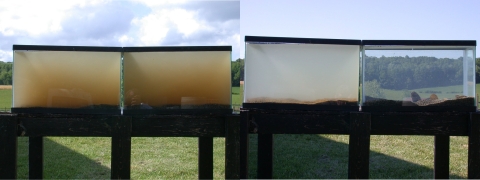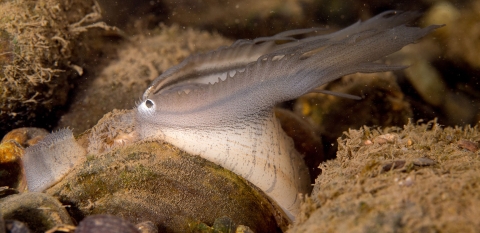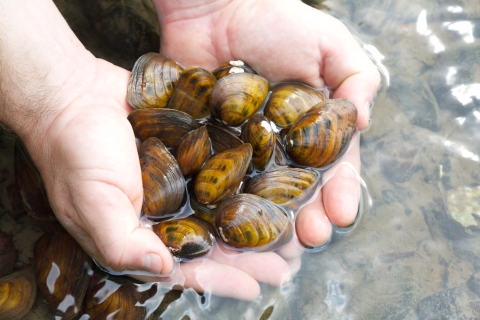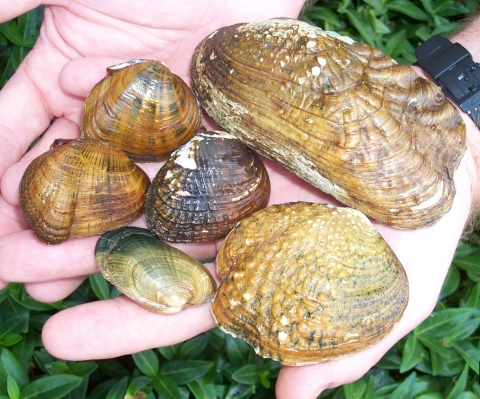More than a pretty . . . shell
We often covet mollusks simply for their shells. Some are swirled or spiraled, some are striped and banded, and others may seem rather plain and unassuming — tossed back to the water’s edge without thought.
Even freshwater streams, rivers and lakes can hold a trove of shells, but have you ever thought about the living creatures that created them? Across the United States, many freshwater mussels are facing a crisis. Their waters are often polluted, or fragmented, leaving the fish they depend on stranded behind barriers, just out of reach.
Let’s be honest, mussels don’t really seem like much: two shells, some squishy yet tough material on the inside, a foot . . . if you can call it that. Some of them have a flap of skin — that often looks uncannily like a fish — they use as a lure to entice unsuspecting fish that will act as involuntary hosts for their eggs. How an animal with no eyes has adapted to pretend part of it is a fish (including the eyes) we will never know.
With no “snoot to boop” it’s kind of hard to form a connection. Or is it . . .
Liver of the river
Question for the audience, do you drink water? Huzzah, you are (perhaps distantly) connected to mussels. Humans have benefited from the cleaning power of mussels since prehistoric times. These little rounded sweepers don’t exactly zoom around picking up dirt, but they do filter sediment, microbes, bacteria and even pollutants out of water that passes by them — not unlike the detoxifying effects of your own liver. Before water treatment plants, mussels were the OG (original) at-home filtration water pitcher.
As you can imagine, this benefit extends to every living thing in their community.
Now that you know how this faceless, liver of waterbodies-the-nation-over functions for the sake of other species, let’s talk a little about their lives.
Zen mastery — in with the bad out with the good
A mussel has a sedimentary, wait, sedentary lifestyle. It hangs out at the bottom where water over(head?) passes by and opens its two shells to expose an inhalant aperture. Yes, you read that right. Perhaps better known as a siphon, the mussel pulls water (think of drawing liquid into a syringe) into the opening and through gills and then pushes anything it can’t consume out of its, you guessed it, exhalant aperture.
Essentially, they breathe in potentially dirty water, clean it of detritus, eat the good stuff, and breathe out clear (or at least cleaner) water. What little champions of positivity, practically meditative. Who couldn’t use little friends who take in the bad and put out goodness — therapists would be out of a job!
Luck be a lady
Clearly, we could use more native freshwater mussels in our midst, but their breeding practices are a particular issue for their collective success. Many mussels require a host fish to attach their tiny babies (larvae) to. Given that a mussel has one foot and no hands, this is quite the process.
Some female mussels are equipped with a fishing lure, probably one better than you can buy at a bait and tackle store.
A female mussel flips out this flap of skin, often wiggling it to resemble a fish swimming. Hoping to catch the eye of a bigger fish, she waits patiently, lure out and moving, until, with a little luck, she gets a literal bite. As the host fish bites her lure (her body, quite honestly), she almost explodes a cloud of baby mussels into the face, and better yet gills, of the unsuspecting would-be predator.
The tiny larval mussels attach to the gills of the fish and hitch a ride to new homes. The problem is, fish are often thwarted by dams and other barriers blocking the way to their historical neighborhoods. Often the host fish can’t even make it to where the mussels live. These fish-passage barriers are thus stymieing the lifecycle of fish and mussels.
But guess what, we can fix that!
Fresh funding for the future
The Inflation Reduction Act and Bipartisan Infrastructure Law Bipartisan Infrastructure Law
The Bipartisan Infrastructure Law (BIL) is a once-in-a-generation investment in the nation’s infrastructure and economic competitiveness. We were directly appropriated $455 million over five years in BIL funds for programs related to the President’s America the Beautiful initiative.
Learn more about Bipartisan Infrastructure Law are funding several projects aimed at saving mussels in the Northeast and across the country. Watersheds throughout the United States provide homes to dozens of threatened or endangered mussel species. This much-needed financial support bolters efforts to help species in need, like the shiny pigtoe and northern riffleshell.
More than $1 million from the Inflation Reduction Act, will support freshwater mussels through restoration, recovery, reintroduction, monitoring and propagation efforts. Often projects extend outside the Northeast, requiring collaboration and coordination across state and regional lines. Here are the five new projects positively impacting 30 freshwater mussel species:
- National Freshwater Mussel Propagation & Genetics, $575,000
- Clinch River Shoal Mussel Propagation and Health Screening, $150,000
- Northern Riffleshell and Clubshell Site-specific Protection and Management, $150,000
- Northern Riffleshell and Clubshell Habitat Restoration and Reintroduce Via Translocation or Artificial Propagation, $130,000
- Monitoring to Support Recovery of Listed Mussels and Associated Recovery Plans, $50,000
More than $2.2 million from the Bipartisan Infrastructure Law will restore habitat; improve stream connectivity, water quality and population resiliency; and create a living classroom for future study.
- Clinch River Watershed Fish Passage Restoration: Little River Mill Dam Removal, $200,000
- Cheat River Albright Power Station Dam Removal, $1,000,000
- Upper Greenbrier River Watershed Fish Passage, $939,500
- Living Shoreline Design and Permitting along Urban Delaware Riverfront, $96,824
Bringing down barriers
With new funding infused into freshwater mussel conservation projects nationwide, there is much reason for hope. Whether physically removing barriers like dams, actively propagating at fisheries, or helping you understand the significance of this incredible animal, the Service and partners are diligently moving forward on a variety of methods aimed at solidifying the success of freshwater mussels.
They may not have faces, but they do look like they’re smiling.
Do you want to help out your friendly neighborhood mussels? Ensure your trash goes to the landfill, and that any toxins, chemicals or un-needed or expired medicines make their way through the correct disposal channels and are not simply thrown out with the garbage.








